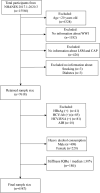Association of weight-adjusted-waist index with non-alcoholic fatty liver disease and liver fibrosis: a cross-sectional study based on NHANES
- PMID: 37537679
- PMCID: PMC10399060
- DOI: 10.1186/s40001-023-01205-4
Association of weight-adjusted-waist index with non-alcoholic fatty liver disease and liver fibrosis: a cross-sectional study based on NHANES
Abstract
Aim: The purpose of this study was to explore the association of weight-adjusted-waist index (WWI) with non-alcoholic fatty liver disease (NAFLD) and liver fibrosis.
Methods: A cross-sectional study including 6587 participants was conducted in the National Health and Nutrition Examination Survey (NHANES). Multiple linear regression was used to validate the association of WWI with NAFLD and liver fibrosis, and smoothed curve fitting and threshold effect models were used to validate non-linear relationships. Subgroup analyses were used to verify the stability of the relationship between the independent and dependent variables in different populations.
Results: There was a positive association of WWI with NAFLD and liver fibrosis. In the model adjusted for all covariates, the effect values of WWI with NAFLD and liver fibrosis were (OR = 3.44, 95% CI: 3.09-3.82) and (OR = 2.40, 95% CI: 2.05-2.79), respectively. This positive correlation became more significant as WWI increased when WWI was presented in quartiles (P for trend < 0.01). Smoothed curve fitting and threshold effects analysis suggested a non-linear correlation between WWI and NAFLD (LLR < 0.01), with the positive correlation between WWI and NAFLD becoming more significant when WWI was less than 11.44 [5.93 (95% CI: 5.04-6.98)]. However, there was a linear correlation between WWI and liver fibrosis (LLR = 0.291). When subgroup analyses were performed by indicators such as age, race and gender, we found that the positive association between WWI and the dependent variables (NAFLD and liver fibrosis) was more pronounced in white male participants aged < 40 years.
Conclusions: Among adults in the United States, WWI was positively associated with the prevalence of NAFLD and liver fibrosis. Participants with a WWI less than 11.44 should be cautious about the possibility of an increased risk of NAFLD development due to a higher WWI. Meanwhile, white males younger than 40 years of age should be more cautious about the higher risk of NAFLD and liver fibrosis that might be associated with an increased WWI.
Keywords: Cross-sectional study; Liver fibrosis; National health and nutrition examination survey; Non-alcoholic fatty liver disease; Weight-adjusted waist index.
© 2023. BioMed Central Ltd., part of Springer Nature.
Conflict of interest statement
Researchers declare that there were no commercial or financial relationships that might pose a conflict of interest in their research. No competing interests.
Figures



Similar articles
-
Association between weight-adjusted waist index and hepatic steatosis and fibrosis: Analyses of the NHANES 2017 to 2020.Medicine (Baltimore). 2025 Jun 6;104(23):e42708. doi: 10.1097/MD.0000000000042708. Medicine (Baltimore). 2025. PMID: 40489808 Free PMC article.
-
Weight-adjusted waist circumference index with hepatic steatosis and fibrosis in adult females: a cross-sectional, nationally representative study (NHANES 2017-2020).BMC Gastroenterol. 2025 Mar 5;25(1):137. doi: 10.1186/s12876-025-03706-4. BMC Gastroenterol. 2025. PMID: 40045243 Free PMC article.
-
Association of metabolic evaluation of visceral fat score with nonalcoholic fatty liver disease and liver fibrosis: A cross-sectional study based on NHANES.Medicine (Baltimore). 2025 Apr 25;104(17):e42213. doi: 10.1097/MD.0000000000042213. Medicine (Baltimore). 2025. PMID: 40295270 Free PMC article.
-
A positive relationship between weight-adjusted waist index and non-alcoholic fatty liver disease: a study on US adolescents.Front Med (Lausanne). 2025 Jan 7;11:1424667. doi: 10.3389/fmed.2024.1424667. eCollection 2024. Front Med (Lausanne). 2025. PMID: 39845834 Free PMC article.
-
Association between Weight-Adjusted Waist Index and depressive symptoms: A nationally representative cross-sectional study from NHANES 2005 to 2018.J Affect Disord. 2024 Apr 1;350:49-57. doi: 10.1016/j.jad.2024.01.104. Epub 2024 Jan 12. J Affect Disord. 2024. PMID: 38220117 Review.
Cited by
-
A J-shaped relationship between body mass index and the risk of elevated liver stiffness: a cross-sectional study.Eur J Med Res. 2023 Dec 4;28(1):557. doi: 10.1186/s40001-023-01543-3. Eur J Med Res. 2023. PMID: 38049896 Free PMC article.
-
Body Mass Index and Waist Circumference as Predictors of Above-Average Increased Cardiovascular Risk Assessed by the SCORE2 and SCORE2-OP Calculators and the Proposition of New Optimal Cut-Off Values: Cross-Sectional Single-Center Study.J Clin Med. 2024 Mar 27;13(7):1931. doi: 10.3390/jcm13071931. J Clin Med. 2024. PMID: 38610696 Free PMC article.
-
Association between weight-adjusted waist index and carotid atherosclerotic plaque in patients with type 2 diabetes in the Chinese population.Diabetol Metab Syndr. 2025 Apr 15;17(1):129. doi: 10.1186/s13098-025-01685-w. Diabetol Metab Syndr. 2025. PMID: 40235002 Free PMC article.
-
Flavonoids intake and weight-adjusted waist index: insights from a cross-sectional study of NHANES.Front Nutr. 2024 Jun 18;11:1400726. doi: 10.3389/fnut.2024.1400726. eCollection 2024. Front Nutr. 2024. PMID: 38957872 Free PMC article.
-
Weight-adjusted waist index and cardiovascular disease: a population-based study in Ravansar, Iran.Arch Public Health. 2024 Nov 20;82(1):219. doi: 10.1186/s13690-024-01451-w. Arch Public Health. 2024. PMID: 39568057 Free PMC article.
References
MeSH terms
Grants and funding
LinkOut - more resources
Full Text Sources
Medical

